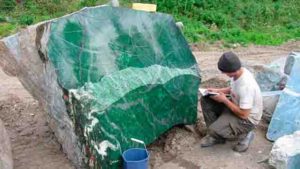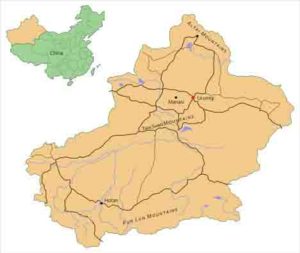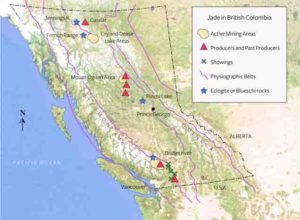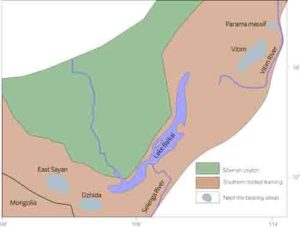
Nephrite is a variety of the calcium, magnesium, and iron-rich amphibole minerals tremolite or actinolite (aggregates of which also make up one form of asbestos). The chemical formula for nephrite is Ca2(Mg, Fe)5Si8O22(OH)2. It is one of two different mineral species called jade. The other mineral species known as jade is jadeite, which is a variety of pyroxene. While nephrite jade possesses mainly grays and greens (and occasionally yellows, browns or whites), jadeite jade, which is rarer, can also contain blacks, reds, pinks and violets. Nephrite jade is an ornamental stone used in carvings, beads, or cabochon cut gemstones.
Nephrite can be found in a translucent white to very light yellow form which is known in China as mutton fat jade, in an opaque white to very light brown or gray which is known as chicken bone jade, as well as in a variety of green colors. Western Canada is the principal source of modern lapidary nephrite. Nephrite jade was used mostly in pre-1800 China as well as in New Zealand, the Pacific Coast and Atlantic Coasts of North America, Neolithic Europe, and southeast Asia.
Name
The name nephrite is derived from lapis nephriticus, which in turn is derived from Greek λίθος νεφριτικός; νεφρός λίθος, which means ‘kidney stone’ and is the Latin and Greek version of the Spanish piedra de ijada (the origin of “jade” and “jadeite”).[3] Accordingly, nephrite jade was once believed to be a cure for kidney stones.
Commercially Important Sources
Green nephrite occurs along the contacts between serpentinite units and more silicic (rich in silica) rocks such as granitic intrusive bodies, argillite, chert, or greywacke in obduction settings, where continental and oceanic crusts collide (Harlow at al., 2005). Its formation results from metasomatic reactions promoted by the presence of calcium-rich hydrous fluid along the contacts (Harlow et al., 2005).
Although deposits around the globe share a similar geological setting, there is no single formation model. Since serpentinite belongs to ophiolite belts and ophiolite is of oceanic origin, it’s only transported to land by subduction or obduction. Subduction and obduction occur during continental-oceanic collisions, so most ophiolite belts occur along old suture zones and current subduction zones.
The most economically important green nephrite sources are located in northwestern China, British Columbia, and Siberia. They are all major suppliers for the China market.
XINJIANG, CHINA

Hetian, also known as Hotan, is located in northwestern China (Xinjiang Uygur Autonomous Region) and has always been synonymous with the best nephrite. The area is known for yielding the famous top-quality white “mutton fat” jade.
Traditionally named “Hetian Jade” is mainly from the Kunlun (Karakoram) and A’erjin (Altai) Mountains. Most of the production from these two areas is white, light greenish white, or light green. Nephrite with a very obvious green hue is called “green nephrite” (“Bi Yu” in Chinese). Most green jade production is from the Manasi River Valley in the south of Jungar Basin. Primary deposits are located on the north slope of the Tian Shan (or Tien Shan) Mountains. In the trade it is called “Manasi green jade.
The mining of Manasi green nephrite has a long history. During the Qing dynasty, it was completely controlled by the imperial court. In 1789, Emperor Qianlong ordered the closing of the area’s green nephrite mines. After that, the mines were dormant for more than 180 years. In 1973, the topic of green nephrite resources and mining was raised in a national meeting. This facilitated the reopening of the old mines and exploration in search of new resources.
Local government support led to the establishment of a nephrite carving factory in Manasi County in 1974. That year, green nephrite production reached several tens of tons. The rough was transported to carving factories in southern China. Finished products mainly supplied the domestic market.
BRITISH COLUMBIA, CANADA

There are more than 50 nephrite occurrences in British Columbia (Simandl et al., 2000 ogden mine article), all distributed along the Cordilleran belt that extends from Alaska to California at irregular intervals along the continent’s margins (Leaming, 1995). This belt includes different regions of oceanic origin that contain the rocks necessary for green nephrite formation. These regions became part of the continent during subduction that occurred in the Mesozoic (Davis et al., 1978).
Until the 1960s, almost all of the nephrite produced in British Columbia came from secondary deposits. With the rapid expansion of amateur lapidary activity after World War II, production in British Columbia’s jade fields picked up and they became the most important suppliers. About the same time, markets opened up in Germany and the Orient. Mining activity gradually depleted the secondary deposits, but increasing values led to further exploration. These efforts uncovered primary deposits adjacent to the Fraser River area in southern British Columbia, the Mount Ogden area in central British Columbia, and the Cassiar jade fields in the far north. Today, British Columbia is the main supplier for the China market.
Jade West Group, founded in 1981, is the biggest player in green nephrite mining and trading in British Columbia. Kirk Makepeace, the company’s founder, is an avid promoter of the stone. He started with a summer job as a jade driller. This involved flying into remote areas and spending summers in tents, with supplies brought by small planes every two weeks. Carrying drills in a backpack, he hiked the countryside in search of jade boulders. He drilled cores from them to determine potential quality. About three out of 100 boulders he drilled were of marketable quality.
More than thirty years later, Jade West has become one of the world’s leading producers and exporters of green nephrite jade. The company owns and operates three out of the four active nephrite mines in British Columbia, including the famous Polar Mine near Dease Lake, and the Kutcho and Ogden Mountain mines. The Polar Mine’s high-quality production is known as Polar Jade in the trade.
Nephrite mining in British Columbia is very challenging. Winters are long and harshly cold, and deposits are remote, so mining can only happen during the short summer season, about 60 days a year. Almost all of the secondary deposits are exhausted, so current mining is almost all from primary deposits. Transporting the heavy equipment to the mining sites is backbreaking work.
Jade West uses diamond-coated circular and wire saws and modern high-pressure hydraulic splitters to remove the nephrite from the mountain and saw it into pieces of a manageable size. Nephrite’s excellent toughness makes it extremely difficult to break out of the rock. While blasting had been used in the past, Jade West no longer uses explosives.
Nephrite deposits range from 12 inches to 12 feet wide. The wider deposits are very challenging to quarry. Nephrite boulders on the surface sometimes reach weights of 200 tons and are rarely under 100 pounds, but Jade West tries to limit the weight of its boulders to five tons, which is a reasonable size for them to mine, handle, and transport on trucks to the nearest town, about 100 miles away. The average weight is two tons, a size that satisfies most of the carving factories in China.
Sophisticated exploration techniques and an understanding of the area’s geology are the keys to successful mining operations and lengthening of a mine’s productive life. Jade West Group invests a lot of capital in its exploration projects. The company adopted core drilling in 1975, and it’s still their most powerful and reliable exploration tool. They drill into the mountain with water-cooled diamond-tipped drills, then extract the cores and examine them to determine if the nephrite is of suitable quality to turn into a marketable finished product. Since the mining season is short, the miners must call on a great deal of experience when determining the areas from which they will take core samples.
SIBERIA, RUSSIA

Although it entered the China market only about 10 to 15 years ago, green nephrite from Russia has gained a great reputation because of its bright color and good transparency. Both white and green nephrite are mined in Russia. Some of the white stones can be of equal quality to the most sought-after “mutton fat” jade and can be sold for high prices in China. Green nephrite is more readily available than the white varieties.
The first green nephrite boulders were discovered on riverbanks in Russia’s Sayan area in 1826. There were additional discoveries in 1851 along the Onot River. The first primary nephrite deposit was reportedly discovered in 1986 (Burtseva et al., 2015).
Siberian nephrite mines are located in extremely remote areas of Russia, in the Eastern Sayan Mountains and the Dzhida areas to the southwest of Lake Baikal, along with the Parama massif to the northeast of the lake. The Sayan Mountains are geographically and geologically related to the Altai Mountains that cross northwestern China, northern Mongolia, and Southwestern Russia. Many people believe that this connection is the reason for the similar qualities of nephrite from China and Russia.
The green nephrite mines that the Chinese are familiar with are almost all clustered in the Eastern Sayan Mountains. From 2005 until now, Chinese nephrite dealers have been sourcing much of their inventory from these mines. Located along the southern margin of the Siberian craton, this area covers over 250 square kilometers. The Russians have recognized and carefully studied more than 50 ultramafic rock units (Burtseva et al., 2015), almost all within the Ospa-Kitoi and Khara-Nur massifs.
The three largest green nephrite mines include Ospa (known to the Chinese as #7 and #11 mines), Gorlygol (known to the Chinese as #10 mine) and Ulankhoda. There are 15 recognized nephrite veins in the Ospa deposit, more than 30 in Gorlygol, and more than 20 in Ulankhoda (Burtseva et al., 2015). Green nephrite formation occurs along the contact between serpentinites and metasomatized mafic and felsic dikes (Burtseva et al., 2015).
The mining of Siberian green nephrite is extremely challenging due to a combination of harsh weather conditions and extremely rugged local terrain. The mining sites can best be accessed by helicopter in the summer or by heavy duty trucks along frozen rivers in winter. Explorers need to fly to Irkutsk, the nearest transitional city, and start from there. It takes at least four to five days to reach the mining sites. Retired six-wheel army trucks are the most available and reliable transport vehicles.
Russian geologist Dr. Sasha Sekerin was one of the earliest explorers of nephrite deposits in the Western and Eastern Sayan Mountains. Today, he remains a highly respected jade expert in Russia. Dr. Sekerin served as a research scientist in the Zemnoy Kory (Earth Crust) Institute in Irkutsk for over a decade until the Soviet Union fell apart. He then became a nephrite jade miner. Sasha and his colleagues began exploring the area in 1975 and have guided foreign explorers and nephrite investors to the area over the past decade.
To mine the nephrite, miners inject expansion agents into fractures in the giant rocks. They limit the use of explosives to protect the nephrite from damage. After injecting the agents, they wait a year, during which natural temperature changes help to fracture the rocks and get them ready for the mining season. The miners label the rocks to avoid conflicting claims, but due to increasing demand and skyrocketing prices, some locals will risk extracting the labeled claims during the winter. Large extracted nephrite is sawn on-site so it’s a reasonable size for transport.
Reference:
The Nephrite Jade Road: Evolution of the Green Nephrite Market
Wikipedia: Nephrite










